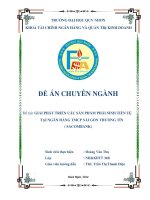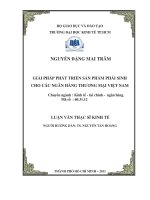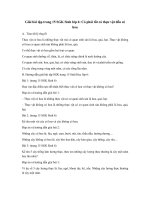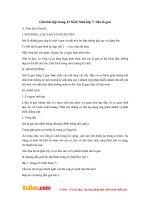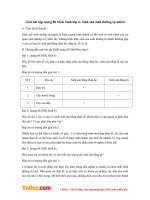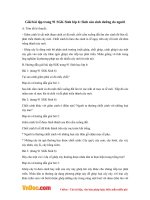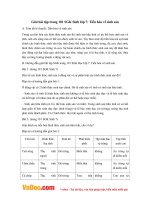Giải bài tập Sản phẩm phái sinh Chương 9
Bạn đang xem bản rút gọn của tài liệu. Xem và tải ngay bản đầy đủ của tài liệu tại đây (105.92 KB, 7 trang )
CHAPTER 9: PRINCIPLES OF PRICING FORWARDS, FUTURES, AND OPTIONS ON FUTURES
END OF CHAPTER QUESTIONS AND PROBLEMS
1.
(Forward/Futures Pricing Revisited) The futures price will not be the expected spot price in September
because the dominance of the long hedgers will induce a risk premium. Thus, the futures price of $2.76 is
biased low. Without information on the magnitude of the risk premium, it is impossible to come up with a
precise estimate. The expected spot price in September, however, is no less than $2.76. Of course, the
actual spot price in September could be far less.
2.
(Early Exercise of Call and Put Option on Futures) In Chapters 3, 4 and 5 we covered American call
options on the spot and explained that in the absence of dividends they will not be exercised early. They
will always sell for at least the lower bound, which is higher than the intrinsic value, and usually more.
Call options on the futures, however, might be exercised early. If the price of the underlying instrument is
extremely high, the call will begin to behave like the underlying instrument. For an option on a futures,
this means that the call will behave like the futures, changing almost dollar-for-dollar with the futures
price. For an option on the spot, the call will behave like the spot, changing almost one-for-one with the
price of the spot. Exercise of the futures call will release funds tied up in the call and provide a position in
the futures. Exercise of the call on the spot does not, however, release funds, since the investor has to
purchase the spot instrument.
3.
(Black Futures Option Pricing Model) The Black model is not an American option on futures pricing
model and Eurodollar options on futures are American. Also the Black model assumes constant interest
rates. Since Eurodollars are interest-sensitive instruments, they violate an assumption of the model.
4.
(Black Futures Option Pricing Model) A spot option pricing model such as Black-Scholes-Merton is a
model for pricing options on instruments with a cost of carry of r c (or r c – δ if there is a dividend yield).
Since a futures requires no outlay of funds nor does it incur a storage cost, it has no cost of carry. The cost
of carry relevant to the futures price is the cost of carry of the underlying spot instrument. An option on a
futures is, therefore, an option on an instrument with a zero cost of carry. The futures option pricing model
is the same as the spot option pricing model where the spot price is replaced with the futures price and the
cost of carry is zero. The latter is established by assuming a dividend yield equal to the interest rate.
5.
(Value of a Forward Contract) The value of the forward contract can be found by subtracting the present
value of the forward price from the current spot price. Thus, the value of the contract is
$52 – $45(1.10) -0.5 = $9.09.
This is the correct value of the contract at this point, six months into the life of the contract, because it is
the value of a portfolio that could be constructed at this time to produce the same result six months later.
That is, you could buy the asset costing $52 and take out a loan, promising to pay $45 in six months. This
combination would guarantee that you would receive at time T, six months later, the value of the asset S T
minus the $45 loan repayment, which is the value of the forward contract when it expires.
6.
(Value of a Futures Contract) The value at the opening is
899.70 – 899.30 = 0.40
In dollars, this is
0.40($250) = $100
An instant before the close, the value is
Chapter 9
66
End-of-Chapter Solutions
© 2010 Cengage Learning. All Rights Reserved. May not be scanned, copied or duplicated, or posted to a publicly accessible website, in whole or in
part.
(899.10 – 899.30) = –0.20
In dollars, that is
–0.20($250) = –$50
After the market has closed, the contract is marked-to-market, the gain or loss is distributed, and the value
is zero.
7.
(Price of a Futures Contract) Consider a futures contract on a stock. Say you sell short the stock and buy
the futures. You receive S 0 up front and during the holding period you earn interest of iS 0. If the stock
pays dividends, a short seller has to make them up so you would incur a cost of D T where DT is the
compound future value of the dividends. At expiration, you accept delivery of the stock and pay f. Thus
your profit is
S0 – f0(T) + iS0 – DT
Since this must equal zero,
f0(T) = S0 + iS0 – DT
8.
9.
(Spot Prices, Risk Premiums, and the Carry Arbitrage for Generic Assets) (a) In a market with risk
premiums, the futures price underestimates the spot price at expiration by the amount of the risk premium.
Therefore, the expected spot price in December is $3.64 + $0.035 = $3.675.
(b)
Arbitrage assures us that whether or not a risk premium exists, the futures price equals the spot
price plus the cost of carry. This is confirmed by noting that the spot price of $3.5225 plus the
cost of carry of $.1175 equals the futures price of $3.64.
(c)
The answer is apparent in part (a). The expected price of wheat in December exceeds the futures
price by the risk premium.
(d)
If there is a risk premium, holders of long futures contracts expect to sell them for a profit equal
to the risk premium. Thus, the expected futures price at expiration is $3.64 + $.035 = $3.675,
which is also the expected spot price at expiration.
(e)
Speculators who take long positions in futures earn the risk premium. They do so because they
are supplying insurance to the hedgers and, therefore, expect to receive a return in compensation
for their willingness to take the risk.
(Stock Indices and Dividends) (a) T = 73/365 = 0.2
f0(T) = 956.49e(0.0596 - 0.0275)(0.2) = 962.65
At 960.50, it is underpriced.
(b) f0(T) = 956.49(1 + 0.0596)0.2 – 5.27= 962.36
At 960.50, it is underpriced. The main difference is compounding of interest. Annual compounding
results in lower proceeds than continuous, hence the annual compounded carrying cost is lower than the
continuous compounding.
10.
(Futures Prices and Risk Premia) E(S T) = 60, E() = 4, = 5.50
Chapter 9
67
End-of-Chapter Solutions
© 2010 Cengage Learning. All Rights Reserved. May not be scanned, copied or duplicated, or posted to a publicly accessible website, in whole or in
part.
E(S T) = E(fT(T)) = 60
f0(T) = E(fT(T)) – E() = 60 – 4 = 56
11.
(Foreign Exchange) (a) S0 = $0.009313, F = $0.010475, r = 0.0615, = 0.0364
With annual compounding, the forward rate should be
1.07 (730/365)
($0.009313 )
1.01(730/365)
$0.01045
So the forward rate should be $0.01045 but is actually $0.010475. Thus, the forward contract is
overpriced. You should buy the yen in the spot market and sell it in the forward market.
(b) With continuous compounding, the forward rate should be
$0.009313e 0.07 0.01 730 / 365 $0.01050
So the forward rate should be $0.01050 but is actually $0.010475. Thus, the forward contract is
underpriced. You should sell the yen in the spot market and buy it in the forward market.
12.
(Put-Call Parity of Options on Futures) 100 days between September 12 and December 21, T = 100/365
= 0.2740
C(f0(T),T,X) – P(f0(T),T,X) = 26.25 – 3.25 = 23
(f0(T) – X)(1 + r) -T = (423.70 – 400)(1.0275) -0.2740 = 23.52
We can view the futures as overpriced and assume the call and put are correctly priced. We sell the
futures, buy a call and sell a put.
Payoffs at Expiration
ST X
–(S T – f0(T))
0
–(X – ST)
f0(T) – X
Short futures
Long call
Short put
ST > X
–(S T – f0(T))
ST – X
0
f0(T) – X
f0(T) – X = 423.70 – 400 = 23.70. The present value of this is 23.70(1.0275) -0.2740 = 23.52. The portfolio
will cost 26.25 – 3.25 = 23.00. Thus, you will earn a present value of 23.52 – 23 = 0.52.
13.
(Pricing Options on Futures) The option’s life is January 31 to March 18, so
T = 46/365 = 0.1260
a.
Intrinsic Value
= Max(0, f0 – X)
= Max(0, 483.10 – 480)
= 3.10
b.
Time Value
= Call Price – Intrinsic Value
= 6.95 – 3.10
Chapter 9
68
End-of-Chapter Solutions
© 2010 Cengage Learning. All Rights Reserved. May not be scanned, copied or duplicated, or posted to a publicly accessible website, in whole or in
part.
= 3.85
c.
Lower bound
= Max[0, (f0 – X)(1 + r) -T]
= Max[0, (483.10 – 480)(1.0284) -0.1260]
= 3.09
d.
Intrinsic Value
= Max(0, X – f0)
= Max(0, 480 – 483.10)
=0
e.
Time Value
= Put Price – Intrinsic Value
= 5.25 – 0
= 5.25
f.
Lower bound
= Max[0, (X – f0)(1 + r) -T]
= Max[(0, (480 – 483.10)(1.0284) -0.1260]
=0
(Note: the lower bound applies only to European puts.)
g.
C
= P + (f0 – X)(1 + r) -T
= 5.25 + (483.10 – 480)(1.0284) -0.1260
= 8.34
The actual call price is 6.95, so put-call parity does not hold.
14.
(Put-Call Parity of Options on Futures) (f0 – X)(1 + r) -T = (102 – 100)(1.10) -0.25 = 1.95
C – P = 4 – 1.75 = 2.25
C – P is too high so the call is overpriced and/or the put is underpriced (or we could assume the futures is
underpriced). So sell the call, buy the put, and buy the futures. At expiration the payoffs will be
Short call
Long put
Long futures
fT X
0
X – fT
fT – f0
X – f0
fT > X
–(fT – X)
0
fT – f0
X – f0
This is equivalent to a risk-free loan, as a lender if X > f 0 or as a borrower if f0 > X. Here f0 > X so you are
a borrower. The present value should be (X – f 0)((1 + r) –T = (102 – 100)(1.10) -0.25 = –1.95. Thus you sell
the call for 4 and buy the put for –1.75 for a net inflow of 2.25. At expiration, you pay back 2.00.
15.
(Black Futures Option Pricing Model) First find the continuously compounded risk-free rate: r c =
ln(1.0284) = 0.0280. Then price the option:
Chapter 9
69
End-of-Chapter Solutions
© 2010 Cengage Learning. All Rights Reserved. May not be scanned, copied or duplicated, or posted to a publicly accessible website, in whole or in
part.
d1 =
=
ln(f 0 /X) + (σ 2 /2)T
σ T
ln(483.10/ 480) + ((.08 ) 2 /2).1260
.08 .1260
= 0.2409
d 2 = d1 - σ T = 0.2409 - .08 .1260 = .2125
N(d 1 ) = N(.24) = .5948 N(d 2 ) = N(.21) = .5832
C = e-rc T [f 0 N(d1 ) - XN(d 2 )]
= e-.0280(.1260) [483.10(.5 948) - 480(.5832) ] = 7.39
The option appears to be underpriced. You could sell e-rcT N(d1 ) = 0.5927 futures and buy one call,
adjusting the hedge ratio through time and earn an arbitrage profit.
16.
(Black Futures Option Pricing Model) P = e - rc T [1 - N( d 2 )] - f e - rc T [1 - N( d1 )]
We already know that N(0.24) = 0.5948 and N(0.21) = 0.5832. Then
P = 480e-0.0280(0.1260)[1 – 0.5832] – 483.10e -0.0280(0.1260)[1 – 0.5948] = 4.30
17.
(Foreign Currencies and Foreign Interest Rates: Interest Rate Parity) The correct forward price is
given by
F 0, T S0
1 r T
1 r
f T
= 1.665(1.015)/(1.02)= 1.6568
Because the forward price is higher than the model price, we will sell the forward contract. If transaction
costs could be covered, you would buy the foreign currency in the spot market at $1.665 and sell it in the
forward market at $1.664. You would earn interest at the foreign interest rate of 2 percent. By selling it
forward, you could then convert back to dollars at the rate of $1.664. In other words, $1.665 would be
used to buy 1 unit of the foreign currency, which would grow to 1.02 units (the 2 percent foreign rate).
Then 1.02 units would be converted back to 1.02($1.664) = $1.69728. This would be a return of
$1.69728/$1.665 – 1 = 0.019387 or 1.9 percent, which is better than the U. S. rate.
18.
(Lower Bound of a European Option on Futures) f0(T) = $100, X = 90, and r = 5%. The lower bound on
a futures option is
Ce(f0(T), T, X) ≥ Max[0, (f0(T) – X)(1 + r) –T] = Max[0, (100 – 90)(1 + 0.05) -1] = 9.5238
The quoted price of $9.40 violates the lower bound and the quoted price is low. Therefore, we would buy
the futures call option and hedge the resulting risk as illustrated in the following cash flow table.
Strategy
Buy futures call option
Today (t=0)
–C = –$9.40
Expiration (f T(T) X)
$0
Sell futures contract
$0 (only margin required)
+f0(T) – fT(T)
= 100 – fT(T)
–(f0(T) – X)
Borrow
Chapter 9
+(f0(T) – X)(1 + r) –T
70
Expiration (f T(T)>X)
fT(T) – X
= fT(T) – 90
+f0(T) – fT(T)
= 100 – fT(T)
–(f0(T) – X)
End-of-Chapter Solutions
© 2010 Cengage Learning. All Rights Reserved. May not be scanned, copied or duplicated, or posted to a publicly accessible website, in whole or in
part.
= +$9.5238
NET CASH FLOW
19.
*(1 + r)–T(1 + r) T
= –$10
X – fT(T) (non-negative
because fT(T) X)
$0.1238
*(1 + r)–T(1 + r) T
= –$10
$0
(Put-Call Party) We now have three versions of put-call parity.
Put-call parity with options on the underlying:
Ce S0 , T, X S0 X1 r
T
Pe S0 , T, X
Put-call parity with options on futures:
Ce f 0 T , T, X f 0 T X 1 r
T
Pe f 0 T , T, X
Put-call futures parity:
Ce S0 , T, X f 0 T X 1 r
20.
T
Pe S0 , T, X
(Black Futures Option Pricing Model) Recall the standard Black-Scholes-Merton option pricing model:
Ce S0 , T, X S0 N d1 Xe rc T N d 2
d1
2
ln S0 rc T
2
X
T
d 2 d1 T
The generic carry formula for forward contracts is
f 0 T S0 e rc T
Solving for S0,
S0 f 0 T e rc T
Substituting this result into the standard Black-Scholes-Merton option pricing formula results in the Black
forward option pricing formula.
Ce f 0 T , T, X e rc T f 0 T N d1 XN d 2
2
f 0 T
T
X
2
d1
T
d 2 d1 T
ln
21.
(Stock Indices and Dividends) (a) Find the future value of the dividends
Chapter 9
71
End-of-Chapter Solutions
© 2010 Cengage Learning. All Rights Reserved. May not be scanned, copied or duplicated, or posted to a publicly accessible website, in whole or in
part.
0.75(1.12) (60/365) + 0.85(1.12) (30/365) + 0.90 = 2.522
f0(T) = 100(1.12) (90/365) – 2.522 = 100.312
(b)
Since f0(T) = S0 + , then = f0(T) – S0 so
100.312 – 100 = 0.312
This is the compound future value of the interest lost minus the compound future value of the
dividends.
22.
(Forward/Futures Pricing Revisited) Let the spot price be S 0, the futures price be f0(T), and the margin
requirement be M. Consider the position of someone who buys the asset and sells a futures contract to
form a risk-free hedge.
Today: Buy the asset, paying S 0, and sell the futures by depositing M dollars in a margin account that earns
the rate q where q < r.
At expiration: The accumulated costs of storage and the interest lost on S 0 dollars add up to θ. When the
trader delivers the asset, he receives f 0(T). The total amount of cash will be f 0(T) – θ + M + interest on M
at the rate q.
Since the transaction is still risk-free, the amount initially invested must grow at the risk-free rate to equal
this future value; however, the spot price does not have to be compounded because the interest on it is
already included in the cost of carry. Thus,
f 0 (T) + M(1 + q ) T (1 + r ) -T - = S + M.
Solving for f0(T) gives
f = S + + M[1 - (1 + q )T (1 + r ) -T].
The bracketed term is the difference in interest between the rate q and rate r. If q is less than r, the whole
bracketed term is greater than zero so the futures price will be greater than the spot price plus the cost of
carry. In other words if the margin account pays interest at less than the risk-free rate, the futures price will
be greater than the spot price plus the cost of carry. The higher futures price compensates for the loss of
interest.
Chapter 9
72
End-of-Chapter Solutions
© 2010 Cengage Learning. All Rights Reserved. May not be scanned, copied or duplicated, or posted to a publicly accessible website, in whole or in
part.


